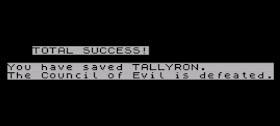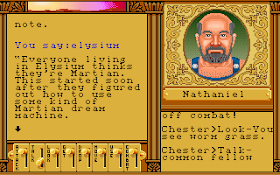 |
| If I can get the power going again, I'm pretty sure those are transport tubes. |
A long time ago, I upset several readers by giving up on Faery Tale Adventure (1987) because it involved too much walking across empty landscapes punctuated only by meaningless combat. It might take 20-minutes in real time to get from one place to another. Well, if I judged Martian Dreams by the same standards, this would be the last entry on the game. All I seem to do in it is to walk.
As I mentioned the last time, the developers took a fairly small landscape--with no barriers, you could probably walk around the circumference of the planet in 5-7 minutes--and sliced it up with uncrossable canals and cliffs. I didn't fully realize the extent of this until I started using and annotating the game map with greater regularity. The game starts in an area (middle of the map) completely enclosed by canals, and the only way to exit is a single bridge to the east. Late in this session, I wanted to travel from Elysium (point A on the map below) to Hellas (point B). Whether I took the clockwise route or counter-clockwise route around the canals, it was about 30 minutes of real-time walking, just holding the direction key the entire time, maybe stopping to fight some plants occasionally. Ultima VI really spoiled us with the moongates and moonstone.
 |
| Click to enlarge. |
To make matters worse, each of the game's quests seems to involve a lot of backtracking, either because you need some obscure tool that you left behind, or because the very nature of the quest takes a journey-and-return approach.
Yes, travel does promise to get easier. Once I get the power restored to the planet, I can extend more bridges over the canals. Once I get those canals flooded with water, I can apparently take barges. And there are some buildings that look like they offer teleportation between cities. The power is thus my primary concern.
My visit to Olympus provided me with several notes about the power and canals, including the location of what Admiral Peary thought was a power station. Before I left the city, I talked with the leader, Jack Segal (no known historical candidate) who seemed like a bit of a blowhard. He had a copy of Machiavelli's The Prince on his bedside table. I suppose this is better than Atlas Shrugged.
 |
| I don't really like this guy. |
I had to cross a bridge north of Olympus and loop around the canals to get to the building described by Peary. Sure enough, there was a central building surrounded by a bunch of broadcast towers, but I couldn't access it because--you guessed it--there was no power to the door.
 |
| This is what we call a "catch-22." |
Without any particular idea what to do next, I decided to skirt around the canal to the south and visit the city of Argyre, where Rasputin is rumored to be holed up, and what looked like a building north of that next to a power tower. I soon found that Argyre's gates were shut and unpenetrable:
 |
| One suspects Rasputin is up to no good. |
I had better luck with the other building. It turned out to be the entrance to some kind of underground coal-fed power station. Caves branching off the man-made (or Martian-made) areas showed signs of mining for coal and iron ore. A series of conveyor belts seemed to be carrying lumps of coal to a boiler room, but one of the belts was broken.
 |
| Yes, it's an homage to Metropolis (1927), which everyone knows about and 6 people have actually seen. |
In the boiler room, I ran into a robot who called himself Stoker. He spoke English, of course. He related that it was his job to carry coal from the end of the conveyor to the furnaces, but the conveyor was broken. Dibbs spoke up at this time and recommended taking the broken belt to an NPC named Trippet (no known historical candidate) in Olympus. This was one of those backtracking quests I talked about.
 |
| Taking the broken conveyor belt... |
 |
| ...getting it fixed by Trippet... |
 |
| ...and returning it. |
I walked to Trippet, got him to repair the belt, and brought it back. It was no effort to re-install it on the conveyor, but the system didn't immediately start up. After more discussions with Stoker, it seemed that I would need to prime the furnaces first. This took me a while because I didn't realize that the true "furnaces" were along a northern wall; I thought I had to put coal directly into the boilers. There was also some confusion about how to use the shovel to move the coal. Eventually, I figured it out. After I put a few shovels-full in the furnaces, a big lump of coal made its way to Stoker, and a cut scene showed him taking over.
 |
| The plant starts to operate on its own. |
A couple of automatic doors opened in the complex, and I found a huge supply of Oxium. It may in fact be unlimited--every time I "use" a hopper, it produces 20 blobs--which will be useful when I return to Buffalo Bill for ammunition.
 |
| So much for the economy. |
I figured my troubles were over, but the next door I tried to open on the surface indicated that it was still closed for lack of power, so clearly it isn't reaching the entire planet. I returned to the power station on the other side of the wall, but there the towers seemed alive and crackling. Stoker had suggested that a cable might be damaged somewhere, so perhaps that's what I'm looking for.
 |
| Power leaps from tower to tower in the restored station. |
Unsure what to do next, I decided to try to visit the other cities, starting with Elysium, where Percival Lowell's party had reportedly gone mad. As I discovered, they weren't mad, just possessed. When the explorers--including Mark Twain, Wyatt Earp, George Washington Carver, Georges Méliès, H. G. Wells, Charles Lewis Tiffay, Vladmir Lenin--discovered the Dream Machine in Elyisum, they found the consciousnesses of Martians already within it. Those Martian consciousnesses replaced the humans', which remain stuck in the Dream Machine. The Martian-humans, going by Martian names like "Xichak" and "Sisik," refer to humans as "worms," although not necessarily in an insulting way.
My discussions with the NPCs in Elysium, plus a scroll I'd found in the power station, filled in most of the backstory of the game. Mars used to host a peaceful and prosperous society of plant-based life living in cities called "groves." Martians were grown from seedlings planted in the compost of their deceased forebears, allowing them to absorb the knowledge and experiences of previous Martians as they grew. Their own creation myths stressed the importance of the lushness and fertility of the planet, so as they developed technology, they tried to put as much of it underground as possible. Those structures that had to be built on the surface, they tried to make unobtrusive.
 |
| A scroll fills in a bit of the story. |
Eventually, a tyrant named Raxachk came to power in Argyre and decided to become the "agrarian" (a high political position) for the entire planet. He created a plague that killed seedlings and threatened to unleash it unless the rest of the planet bowed to his will. Everyone laughed at him, so he released the plague and everyone died. A few Martians used their Dream Machines to trap their consciousnesses as their physical bodies died, and they remained there until humans showed up and started using the machines.
 |
| A Martian inhabiting the body of Charles Lewis (i.e., "Breakfast at") Tiffany describes Raxachk. |
The Martians in Elysium assure us that their possession of human bodies is all temporary. They're hoping to re-grow new seedlings (assuming the plague is gone) and transfer their consciousnesses into new plants. The Martians in Hellas apparently think it's blasphemous to occupy human bodies and have refused, leading to animosity between the two settlements. I was on my way to Hellas when I got killed by some cacti or something. I hadn't saved in a while and I didn't feel like walking all that way again, so I closed the session. My attempts to win the entire game in 3 days using save states didn't work, but the regular save seems to be okay for now.
Anyway, it's clear that I'm going to have to help the Elysium Martians with fertilizer and water as part of the quest. But to get into certain buildings, I need the power back on, so we're back to that. I'll be happy to take a light hint as I check out Wizard's Lair.
Two notes:
- I've been picking berries wherever I find them, but I haven't needed ESP again yet. There are at least three colors, although I can't tell two of them apart. One of them makes me sick; another reveals what's behind walls and closed doors.
 |
| A berry lets me see through this wall. |
- If the Avatar dies, he resurrects back at the capsule thanks to the ministrations of Dr. Blood. But he loses 1,000 experience points in the process, so I reload when I die.
I admit the story is a little more coherent than I expected, but the whole thing is still pretty silly. I almost wish the game would end with "it was all a dream" rather than shoehorn this nonsense into the Ultima canon.
Time so far: 14 hours
Reload count: 5
*******
This is a long shot, but if anyone has or knows where to get a game manual for Les Templiers d'Orven (Loricels, 1986), I would greatly appreciate it.
Time so far: 14 hours
Reload count: 5
*******
This is a long shot, but if anyone has or knows where to get a game manual for Les Templiers d'Orven (Loricels, 1986), I would greatly appreciate it.



































